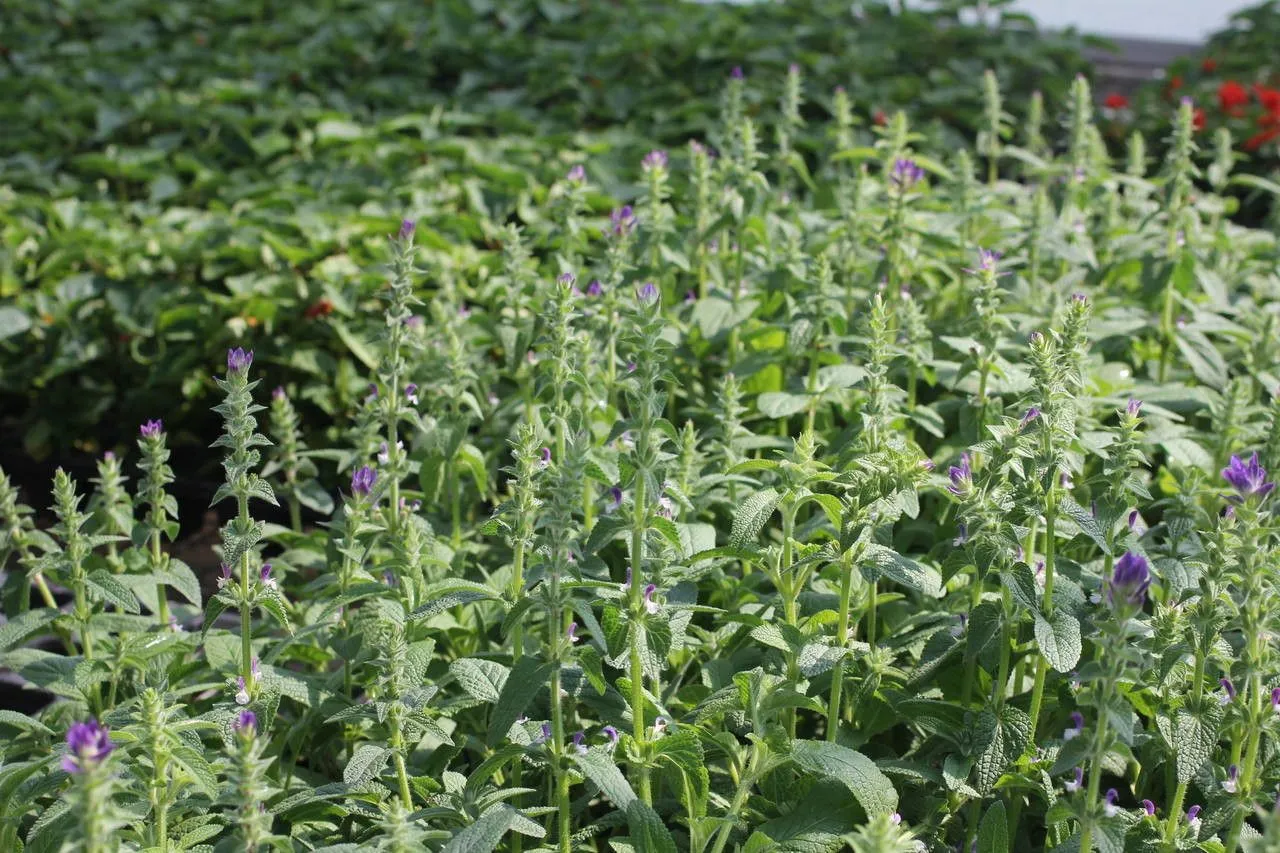
Author: L.
Bibliography: Sp. Pl.: 24 (1753)
Year: 1753
Status: accepted
Rank: species
Genus: Salvia
Vegetable: False
Observations: Medit. to Turkmenistan
Wild clary, scientifically known as Salvia viridis, is a remarkable member of the Lamiaceae family, celebrated for its vibrant and colorful bracts. This enchanting herb is native to the Mediterranean region, extending its natural habitat towards Turkmenistan, showcasing its adaptability to diverse climatic conditions.
Known since 1753, when it was first described in “Species Plantarum,” Salvia viridis has captivated botanists and herbal enthusiasts alike with its distinctive features. The plant is easily recognizable by its bright, eye-catching bracts, which come in shades of pink, white, and purple, often overshadowing the actual flowers. These bracts serve a significant role in attracting pollinators, ensuring the plant’s propagation and survival.
Wild clary thrives in well-drained soils under full sun exposure, making it a popular choice for gardens and landscaping projects. Horticulturists admire it not only for its ornamental value but also for its resilience and relatively low maintenance requirements. Its aromatic leaves add another layer of sensory delight, releasing a pleasant scent when brushed against or crushed.
Beyond its aesthetic appeal, Wild clary holds a place in traditional practices and herbal medicine across its native range. Historically, it has been used for its various purported health benefits, although modern scientific research on its efficacy remains limited. Its presence in cultural folklore underscores the deep connection between nature and human well-being, a bond that has been nurtured over centuries.
In conclusion, Salvia viridis, or Wild clary, stands out as a vibrant and robust specimen within the Lamiaceae family. Its journey from the Mediterranean to regions as far-reaching as Turkmenistan highlights its versatility and enduring charm. Whether viewed through the lens of a gardener, botanist, or historian, this plant continues to intrigue and inspire, a testament to the rich tapestry of the natural world.
Eng: annual clary, bluebeard, wild clary
Dan: blåtoppet salvie, dusk-salvie
Deu: grüner salbei, scharlach-salbei, scharlachsalbei, schopf-salbei, bunter salbei
Fra: sauge verte, hormin
Swe: broksalvia
Spa: hormino, hormino silvestre
Ces: šalvia zelená, šalvěj zahradní
Nob: spraglesalvie
Nno: spreklesalvie
Cym: clari unflwydd
En: Wild clary, Annual clary, Bluebeard, Green Sage
Ar: قصعين أخضر
Az: Yaşıl adaçayı
Bg: Зелен конски босилек
Ca: Ormí
Cs: Šalvěj zahradní, Šalvia zelená
Da: Blåtoppet salvie, Dusk-salvie
Fi: Kirjosalvia
Fr: Sauge verte, Hormin
De: Scharlachsalbei, Bunter Salbei, Schopf-Salbei, Buntschopf-Salbei, Grüner Salbei, Scharlach-Salbei, Schopfiger Salbei
He: מרווה דגולה
It: Salvia annuale
Nb: Spraglesalvie
Nn: Spreklesalvie
Fa: مریمگلی یکساله
Ru: Šalfej zelënyj, Шалфей зелёный
Es: Hormino, Hormino silvestre
Sv: Broksalvia
Cy: Clari unflwydd
Taken Nov 12, 2021 by manos mpouts (cc-by-sa)
Taken Dec 14, 2020 by Jacques Zuber (cc-by-sa)
Taken Dec 14, 2020 by Jacques Zuber (cc-by-sa)
Taken Oct 28, 2021 by Gyongyi PK (cc-by-sa)
Taken Dec 25, 2020 by Aitor Mediavilla (cc-by-sa)
Taken Oct 12, 2019 by claude lerat -gentet Mme (cc-by-sa)
Taken Dec 14, 2020 by Jacques Zuber (cc-by-sa)
Taken Oct 12, 2019 by claude lerat -gentet Mme (cc-by-sa)
Taken Dec 10, 2019 by mel bonv (cc-by-sa)
© copyright of the Board of Trustees of the Royal Botanic Gardens, Kew.
© copyright of the Board of Trustees of the Royal Botanic Gardens, Kew.
© copyright of the Board of Trustees of the Royal Botanic Gardens, Kew.
Taken May 4, 2017 by Antoine AFFOUARD (cc-by-sa)
Taken May 4, 2017 by Antoine AFFOUARD (cc-by-sa)
Taken May 4, 2017 by Antoine AFFOUARD (cc-by-sa)
Taken Jun 9, 2022 by Mélissa Mazard (cc-by-sa)
Taken May 4, 2017 by Antoine AFFOUARD (cc-by-sa)
Taken Oct 1, 2021 by chris rahner (cc-by-sa)
Taken Jul 15, 2020 by Bénédicte OUDART (cc-by-sa)
Taken Aug 5, 2019 by Hanneke Kempenaers (cc-by-sa)
Taken Oct 6, 2022 by Elena Diaz (cc-by-sa)
Taken May 4, 2017 by Antoine AFFOUARD (cc-by-sa)
Taken May 4, 2017 by Antoine AFFOUARD (cc-by-sa)
Taken May 4, 2017 by Antoine AFFOUARD (cc-by-sa)
Taken May 4, 2017 by Antoine AFFOUARD (cc-by-sa)
Taken May 4, 2017 by Antoine AFFOUARD (cc-by-sa)
Taken Apr 15, 2009 by Photoflora – Benoit BOCK (©)
Taken Apr 15, 2006 by Photoflora – Benoit BOCK (©)
Taken Apr 15, 2009 by Photoflora – Benoit BOCK (©)
Taken Dec 15, 2015 by Photoflora – Jean-Luc TASSET (©)
Taken Jan 1, 1970 by Photoflora – L’Abbé COSTE (©)
Bloom months: [‘may’, ‘jun’]
Family: Myrtaceae Author: (F.Muell.) K.D.Hill & L.A.S.Johnson Bibliography: Telopea 6: 402 (1995) Year: 1995 Status:…
Family: Rubiaceae Author: Pierre ex A.Froehner Bibliography: Notizbl. Bot. Gart. Berlin-Dahlem 1: 237 (1897) Year:…
Family: Sapindaceae Author: Koidz. Bibliography: J. Coll. Sci. Imp. Univ. Tokyo 32(1): 38 (1911) Year:…
Family: Asteraceae Author: A.Gray Bibliography: Pacif. Railr. Rep.: 107 (1857) Year: 1857 Status: accepted Rank:…
Family: Fabaceae Author: Medik. Bibliography: Vorles. Churpfälz. Phys.-Ökon. Ges. 2: 398 (1787) Year: 1787 Status:…
Family: Aspleniaceae Author: (Cav.) Alston Bibliography: Bull. Misc. Inform. Kew 1932: 309 (1932) Year: 1932…